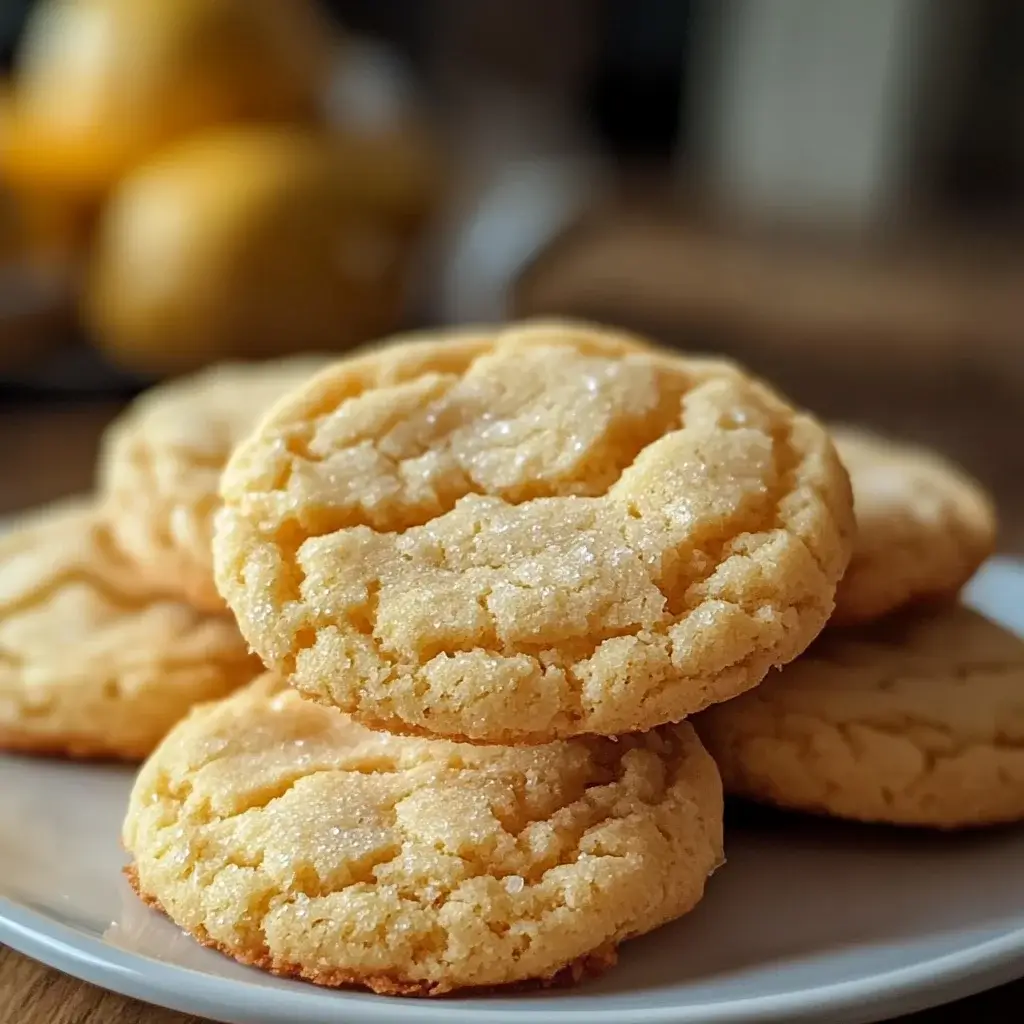Let me tell you, there’s nothing quite like the aroma of freshly baked lemon cookies wafting through the kitchen. Recently, I stumbled upon this recipe for chewy lemon cookies, and let me just say, it’s become an instant favorite in our household. From the moment they emerged from the oven, golden brown and fragrant, I knew we were in for a treat. The first bite was pure bliss – a delightful balance of zesty lemon and sweet cookie goodness, with a perfectly chewy texture that just melts in your mouth. My kids, usually picky eaters, devoured them within minutes, and even my husband, who claims not to have a sweet tooth, went back for seconds (and maybe thirds!). If you’re looking for a cookie recipe that’s bright, cheerful, and utterly irresistible, look no further. This chewy lemon cookie recipe is a guaranteed winner, perfect for a sunny afternoon treat, a bake sale, or simply to brighten up your day. Get ready to experience lemon cookie perfection!
Ingredients
- All-Purpose Flour: The foundation of our cookies, providing structure and texture. We’ll need 3 cups to ensure the perfect balance.
- Granulated Sugar: Adds sweetness and helps create that delightful crispness around the edges. We’re using 1 ½ cups to achieve the ideal level of sweetness.
- Unsalted Butter: Essential for richness, flavor, and that desirable chewy texture. Make sure it’s softened to room temperature for easy creaming. You’ll need 1 cup (2 sticks).
- Large Eggs: Act as a binder, adding moisture and richness to the cookies. Two large eggs are perfect for this recipe.
- Lemon Juice: The star of the show! Freshly squeezed lemon juice provides that bright, zesty flavor. We’ll need ¼ cup for a pronounced lemon taste.
- Lemon Zest: Don’t skip this! Lemon zest is where the real lemon fragrance and intense flavor reside. Use the zest of 2 large lemons for maximum impact.
- Baking Soda: A leavening agent that helps create a soft and chewy texture. We’ll use 1 teaspoon.
- Baking Powder: Works in tandem with baking soda to ensure a light and airy crumb. Use 1 teaspoon.
- Salt: Enhances the flavors and balances the sweetness. Just ½ teaspoon is all you need.
- Powdered Sugar (for rolling): Creates a beautiful crackled appearance and adds a touch of extra sweetness and texture to the outside of the cookies. About 1 cup should suffice.
Instructions
- Prepare for Baking: Begin by preheating your oven to 350°F (175°C). This ensures the oven is at the correct temperature when the cookies are ready to bake, leading to even cooking and preventing them from spreading too thin or burning. Line baking sheets with parchment paper. Parchment paper is crucial as it prevents the cookies from sticking to the baking sheet, making cleanup a breeze and ensuring the bottoms of your cookies bake evenly without burning. Set aside these prepared baking sheets.
- Cream Butter and Sugar: In a large mixing bowl, or the bowl of a stand mixer fitted with the paddle attachment, combine the softened unsalted butter and granulated sugar. Cream these together on medium speed until the mixture is light, fluffy, and pale yellow. This process, known as creaming, is vital for incorporating air into the batter, which contributes to the cookies’ light and airy texture. Creaming also ensures the sugar is well incorporated into the butter, creating a smooth and uniform base for the cookie dough. This step should take about 3-5 minutes. Don’t rush this step; proper creaming is key to achieving the desired cookie texture.
- Incorporate Eggs: Add the large eggs, one at a time, to the creamed butter and sugar mixture. Beat well after each addition, ensuring each egg is fully incorporated before adding the next. This gradual addition allows the eggs to emulsify properly with the fat and sugar, contributing to the cookie’s structure and richness. Continue to beat until the mixture is smooth and well combined.
- Add Lemon Zest and Juice: Now it’s time to infuse that vibrant lemon flavor! Add the freshly squeezed lemon juice and lemon zest to the mixture. Mix until just combined. Be careful not to overmix at this stage. Overmixing after adding liquids can develop gluten, which can make the cookies tough instead of chewy. The lemon zest and juice not only provide the signature lemon flavor but also add moisture and a touch of acidity that balances the sweetness.
- Combine Dry Ingredients: In a separate medium bowl, whisk together the all-purpose flour, baking soda, baking powder, and salt. Whisking is important to evenly distribute the leavening agents and salt throughout the flour, ensuring consistent texture and flavor in every cookie. This pre-mixing of dry ingredients prevents pockets of baking soda or powder in the final cookies.
- Gradually Add Dry Ingredients to Wet Ingredients: Slowly add the dry ingredients to the wet ingredients, mixing on low speed until just combined. Again, be careful not to overmix. Mix just until you no longer see streaks of flour. Overmixing at this stage can lead to tough cookies. The goal is to combine the wet and dry ingredients just until they are incorporated, creating a cohesive dough without developing too much gluten.
- Chill the Dough (Optional but Recommended): For best results, and especially if your kitchen is warm, cover the dough with plastic wrap and chill in the refrigerator for at least 30 minutes, or up to 1 hour. Chilling the dough allows the butter to solidify, which helps prevent the cookies from spreading too much during baking. Chilled dough is also easier to handle and roll into balls. While chilling is optional, it significantly improves the texture and shape of the cookies, making them chewier and less likely to spread thin.
- Shape the Dough: Once the dough is chilled (or if you skipped chilling), use a cookie scoop or a spoon to scoop out rounded tablespoons of dough. Roll each portion of dough into a smooth ball with your hands. Rolling the dough into balls ensures uniform cookie shapes and even baking.
- Roll in Powdered Sugar: Place the powdered sugar in a shallow bowl. Roll each dough ball in the powdered sugar, ensuring it’s generously coated. The powdered sugar coating is what creates the beautiful crackled effect on the cookies as they bake and also adds a delicate sweetness and textural contrast.
- Arrange on Baking Sheets: Place the powdered sugar-coated dough balls onto the prepared baking sheets, spacing them about 2 inches apart. This spacing is important as the cookies will spread slightly during baking. Adequate space prevents them from merging together into one large cookie sheet.
- Bake to Perfection: Bake in the preheated oven for 10-12 minutes, or until the edges are lightly golden brown and the centers are still slightly soft. The baking time may vary slightly depending on your oven. Keep a close eye on the cookies to prevent overbaking. The cookies will continue to set as they cool, so it’s best to take them out when they are just starting to turn golden brown around the edges and still appear slightly soft in the center.
- Cool and Enjoy: Remove the baking sheets from the oven and let the cookies cool on the baking sheets for a few minutes before transferring them to a wire rack to cool completely. Allowing them to cool on the baking sheet for a short time helps them firm up slightly before being moved, preventing them from breaking. Once fully cooled, these chewy lemon cookies are ready to be enjoyed! They are best enjoyed fresh but can be stored in an airtight container at room temperature for up to 3-4 days.
Nutrition Facts
(Per Serving – Serving size: 1 cookie, Recipe yields approximately 24 cookies)
- Calories: Approximately 150-180 kcal
- Fat: 7-9g
- Saturated Fat: 4-5g
Note: Nutritional values are estimates and can vary based on specific ingredients and serving sizes.
Preparation Time
- Prep Time: 20 minutes (includes gathering ingredients, mixing dough, and rolling cookies)
- Chill Time (Optional but Recommended): 30 minutes – 1 hour
- Bake Time: 10-12 minutes per batch
- Total Time (without chill time): Approximately 30-32 minutes
- Total Time (with chill time): Approximately 1 hour – 1 hour 32 minutes
This recipe is relatively quick to prepare, especially if you skip the chilling step. However, for optimal texture and flavor, the chill time is highly recommended. The active preparation time is minimal, making it a great recipe for a quick baking project.
How to Serve
These chewy lemon cookies are incredibly versatile and can be enjoyed in numerous ways:
- Classic Dessert: Serve them as a simple and satisfying dessert after lunch or dinner. Their bright lemon flavor is a refreshing palate cleanser.
- Afternoon Treat with Tea or Coffee: Pair them with a cup of hot tea or coffee for a delightful afternoon pick-me-up. The citrus notes complement both beverages beautifully.
- Party Platter: Arrange them on a cookie platter for parties, gatherings, or potlucks. Their vibrant color and delicious taste make them a crowd-pleaser.
- Gift Giving: Package them in a pretty box or bag to give as a thoughtful homemade gift to friends, neighbors, or teachers.
- Ice Cream Sandwich: Get creative and use them to make lemon cookie ice cream sandwiches with vanilla or lemon flavored ice cream.
- Crumble Topping: Crumble them over yogurt, ice cream, or fruit salad for added texture and flavor.
- Lemon Cookie Crumb Crust: Crush them finely and use them as a base for lemon bars or other dessert crusts for an extra lemony punch.
- With Lemonade: Embrace the lemon theme and serve them alongside a refreshing glass of homemade lemonade on a warm day.
Additional Tips for Perfect Chewy Lemon Cookies
- Use Fresh Lemon Juice and Zest: For the most vibrant and authentic lemon flavor, always use freshly squeezed lemon juice and zest. Bottled lemon juice and pre-zested lemon zest can lack the brightness and intensity of fresh lemons. Zest the lemons before juicing them for easier handling.
- Don’t Overmix the Dough: Overmixing the dough, especially after adding the dry ingredients, can develop the gluten in the flour, resulting in tougher cookies. Mix just until the ingredients are combined and no streaks of flour remain.
- Chill the Dough for Chewier Cookies: Chilling the dough is highly recommended, even if just for 30 minutes. Chilled dough is easier to handle, prevents excessive spreading during baking, and results in chewier, thicker cookies. If you’re short on time, even a brief chill in the freezer can help.
- Use Room Temperature Ingredients: Ensure your butter and eggs are at room temperature. Room temperature butter creams more easily and creates a smoother batter. Room temperature eggs emulsify better into the batter, leading to a more cohesive and even texture.
- Measure Flour Correctly: Incorrectly measured flour is a common baking mistake. Always spoon flour into your measuring cup and level it off with a straight edge. Avoid scooping directly from the bag, as this can compact the flour and lead to using too much, resulting in dry cookies.
- Bake on the Middle Rack: Baking cookies on the middle rack of your oven ensures even heat distribution and prevents the bottoms from burning before the centers are cooked.
- Don’t Overbake: Overbaked cookies will be dry and crumbly instead of chewy. Bake until the edges are just lightly golden brown and the centers are still slightly soft. They will continue to set as they cool. It’s better to slightly underbake than overbake for chewy cookies.
- Store Cookies Properly: Once completely cooled, store the cookies in an airtight container at room temperature. This will keep them fresh and chewy for up to 3-4 days. For longer storage, you can freeze the baked cookies in an airtight container for up to 2-3 months. Let them thaw at room temperature before serving.
FAQ Section: Your Chewy Lemon Cookie Questions Answered
Q1: Can I use margarine instead of butter?
A1: While margarine can be used as a substitute for butter in some recipes, it is generally not recommended for cookies, especially if you are aiming for the best flavor and texture. Butter provides a richness and flavor that margarine often lacks. For the best chewy lemon cookies, stick with unsalted butter.
Q2: Can I use bottled lemon juice instead of fresh?
A2: Freshly squeezed lemon juice is highly recommended for the most vibrant and authentic lemon flavor. Bottled lemon juice can sometimes have a slightly metallic or less fresh taste. However, if you are in a pinch, you can use bottled lemon juice. Just be aware that the flavor might not be quite as bright and zesty.
Q3: My cookies spread too thin. What did I do wrong?
A3: There are several reasons why your cookies might have spread too thin:
* Butter was too warm: Make sure your butter is softened but still cool to the touch, not melted or overly soft.
* Dough was not chilled: Chilling the dough is crucial for preventing excessive spreading.
* Oven temperature was too low: Ensure your oven is preheated to the correct temperature (350°F/175°C).
* Too much sugar: While this recipe is balanced, too much sugar in general can cause cookies to spread.
* Baking sheet was too warm: Avoid placing cookie dough on a warm baking sheet. Let baking sheets cool completely between batches.
Q4: My cookies are not chewy, they are crispy. How can I make them chewier?
A4: To ensure chewy lemon cookies:
* Don’t overbake: Overbaking is the most common reason for crispy cookies. Bake until the edges are just set and the centers are still slightly soft.
* Use enough butter: Butter contributes to chewiness. Ensure you are using the correct amount of butter as specified in the recipe.
* Chill the dough: Chilling the dough helps prevent spreading and results in a chewier texture.
* Brown sugar (optional): While this recipe uses granulated sugar, incorporating a bit of brown sugar in future batches can enhance chewiness due to its molasses content.
Q5: Can I add lemon extract for extra lemon flavor?
A5: Yes, you can add ½ teaspoon of lemon extract to enhance the lemon flavor. Add it along with the lemon juice and zest. Be careful not to add too much lemon extract, as it can be overpowering and even taste artificial if overused.
Q6: Can I freeze the cookie dough instead of chilling it?
A6: Yes, you can freeze the cookie dough. Scoop the dough into balls, roll them in powdered sugar, and then freeze them on a baking sheet until solid. Once frozen, transfer them to an airtight freezer bag. You can bake them directly from frozen, adding a couple of extra minutes to the baking time.
Q7: Can I make these cookies ahead of time?
A7: Yes, you can make these cookies ahead of time. Baked cookies can be stored in an airtight container at room temperature for up to 3-4 days. You can also freeze the baked cookies for longer storage (2-3 months). The dough can also be made a day or two ahead and stored in the refrigerator, or frozen for longer storage.
Q8: Can I make these cookies gluten-free?
A8: To make these cookies gluten-free, you can substitute the all-purpose flour with a gluten-free all-purpose flour blend. Ensure the blend is designed for baking and contains xanthan gum or another binder to provide structure. Gluten-free flours can sometimes absorb liquid differently, so you may need to adjust the amount of liquid slightly. Start by substituting cup-for-cup and observe the dough consistency.
Print
Chewy Lemon Cookies Recipe
Ingredients
- All-Purpose Flour: The foundation of our cookies, providing structure and texture. We’ll need 3 cups to ensure the perfect balance.
- Granulated Sugar: Adds sweetness and helps create that delightful crispness around the edges. We’re using 1 ½ cups to achieve the ideal level of sweetness.
- Unsalted Butter: Essential for richness, flavor, and that desirable chewy texture. Make sure it’s softened to room temperature for easy creaming. You’ll need 1 cup (2 sticks).
- Large Eggs: Act as a binder, adding moisture and richness to the cookies. Two large eggs are perfect for this recipe.
- Lemon Juice: The star of the show! Freshly squeezed lemon juice provides that bright, zesty flavor. We’ll need ¼ cup for a pronounced lemon taste.
- Lemon Zest: Don’t skip this! Lemon zest is where the real lemon fragrance and intense flavor reside. Use the zest of 2 large lemons for maximum impact.
- Baking Soda: A leavening agent that helps create a soft and chewy texture. We’ll use 1 teaspoon.
- Baking Powder: Works in tandem with baking soda to ensure a light and airy crumb. Use 1 teaspoon.
- Salt: Enhances the flavors and balances the sweetness. Just ½ teaspoon is all you need.
- Powdered Sugar (for rolling): Creates a beautiful crackled appearance and adds a touch of extra sweetness and texture to the outside of the cookies. About 1 cup should suffice.
Instructions
- Prepare for Baking: Begin by preheating your oven to 350°F (175°C). This ensures the oven is at the correct temperature when the cookies are ready to bake, leading to even cooking and preventing them from spreading too thin or burning. Line baking sheets with parchment paper. Parchment paper is crucial as it prevents the cookies from sticking to the baking sheet, making cleanup a breeze and ensuring the bottoms of your cookies bake evenly without burning. Set aside these prepared baking sheets.
- Cream Butter and Sugar: In a large mixing bowl, or the bowl of a stand mixer fitted with the paddle attachment, combine the softened unsalted butter and granulated sugar. Cream these together on medium speed until the mixture is light, fluffy, and pale yellow. This process, known as creaming, is vital for incorporating air into the batter, which contributes to the cookies’ light and airy texture. Creaming also ensures the sugar is well incorporated into the butter, creating a smooth and uniform base for the cookie dough. This step should take about 3-5 minutes. Don’t rush this step; proper creaming is key to achieving the desired cookie texture.
- Incorporate Eggs: Add the large eggs, one at a time, to the creamed butter and sugar mixture. Beat well after each addition, ensuring each egg is fully incorporated before adding the next. This gradual addition allows the eggs to emulsify properly with the fat and sugar, contributing to the cookie’s structure and richness. Continue to beat until the mixture is smooth and well combined.
- Add Lemon Zest and Juice: Now it’s time to infuse that vibrant lemon flavor! Add the freshly squeezed lemon juice and lemon zest to the mixture. Mix until just combined. Be careful not to overmix at this stage. Overmixing after adding liquids can develop gluten, which can make the cookies tough instead of chewy. The lemon zest and juice not only provide the signature lemon flavor but also add moisture and a touch of acidity that balances the sweetness.
- Combine Dry Ingredients: In a separate medium bowl, whisk together the all-purpose flour, baking soda, baking powder, and salt. Whisking is important to evenly distribute the leavening agents and salt throughout the flour, ensuring consistent texture and flavor in every cookie. This pre-mixing of dry ingredients prevents pockets of baking soda or powder in the final cookies.
- Gradually Add Dry Ingredients to Wet Ingredients: Slowly add the dry ingredients to the wet ingredients, mixing on low speed until just combined. Again, be careful not to overmix. Mix just until you no longer see streaks of flour. Overmixing at this stage can lead to tough cookies. The goal is to combine the wet and dry ingredients just until they are incorporated, creating a cohesive dough without developing too much gluten.
- Chill the Dough (Optional but Recommended): For best results, and especially if your kitchen is warm, cover the dough with plastic wrap and chill in the refrigerator for at least 30 minutes, or up to 1 hour. Chilling the dough allows the butter to solidify, which helps prevent the cookies from spreading too much during baking. Chilled dough is also easier to handle and roll into balls. While chilling is optional, it significantly improves the texture and shape of the cookies, making them chewier and less likely to spread thin.
- Shape the Dough: Once the dough is chilled (or if you skipped chilling), use a cookie scoop or a spoon to scoop out rounded tablespoons of dough. Roll each portion of dough into a smooth ball with your hands. Rolling the dough into balls ensures uniform cookie shapes and even baking.
- Roll in Powdered Sugar: Place the powdered sugar in a shallow bowl. Roll each dough ball in the powdered sugar, ensuring it’s generously coated. The powdered sugar coating is what creates the beautiful crackled effect on the cookies as they bake and also adds a delicate sweetness and textural contrast.
- Arrange on Baking Sheets: Place the powdered sugar-coated dough balls onto the prepared baking sheets, spacing them about 2 inches apart. This spacing is important as the cookies will spread slightly during baking. Adequate space prevents them from merging together into one large cookie sheet.
- Bake to Perfection: Bake in the preheated oven for 10-12 minutes, or until the edges are lightly golden brown and the centers are still slightly soft. The baking time may vary slightly depending on your oven. Keep a close eye on the cookies to prevent overbaking. The cookies will continue to set as they cool, so it’s best to take them out when they are just starting to turn golden brown around the edges and still appear slightly soft in the center.
- Cool and Enjoy: Remove the baking sheets from the oven and let the cookies cool on the baking sheets for a few minutes before transferring them to a wire rack to cool completely. Allowing them to cool on the baking sheet for a short time helps them firm up slightly before being moved, preventing them from breaking. Once fully cooled, these chewy lemon cookies are ready to be enjoyed! They are best enjoyed fresh but can be stored in an airtight container at room temperature for up to 3-4 days.
Nutrition
- Serving Size: one normal portion
- Calories: 180
- Fat: 9g
- Saturated Fat: 5g






